The Boston fern (Nephrolepis exaltata) is a popular indoor plant that is known for its lush, green fronds and graceful, arching growth habit. The fronds eventually cascade down over your pot and display lovely greenery for lengths of 3 feet or longer. Perfect basket plants.
The Boston fern is also commonly known as the sword fern, Boston blue bell fern, wild Boston fern, or tuber ladder fern. This plant has been grown as a well loved indoor plant companion for over 100 years. It continues to be a favorite among plant enthusiasts today.
This sword fern belongs to the family Lomariopsidaceae. The plant is native to tropical regions of the Americas, including Florida, Central America, and South America. The wild Boston fern was first introduced to the United States in the 1800s and quickly became a popular houseplant.

How did Boston fern get its name? The Boston fern is named after the city of Boston, Massachusetts, where it became popular during the Victorian era. The plant was first commercially cultivated in Boston by a horticulturist named John Smith. Smith propagated this fern and sold it to local gardeners and plant enthusiasts. It acquired the popular name of the Boston Fern, and that stuck as it was distributed around the country.
Boston Ferns As Indoor Plants:
Is a Boston Fern a Good House Plant? Boston ferns make excellent houseplants. Just be willing to provide the simple but necessary growing conditions. The Boston blue bell fern adds a touch of tropical elegance to any indoor space.
What are Boston ferns good for?
In addition to being a beautiful houseplant, Boston ferns are beneficial for the environment. These ferns are known for their ability to purify the air and remove harmful toxins, such as formaldehyde and benzene. Sword ferns are also used in traditional medicine to treat a variety of ailments, including digestive issues, skin conditions, and respiratory infections.
Boston ferns are easy to care for and adapt well to indoor environments. As long as they are provided with the right growing conditions (i.e. bright, indirect light, consistently moist soil, and high humidity), they can thrive in a variety of settings.
Wild Boston ferns can also be grown outdoors in warm, humid climates. With the right care and growing conditions, Boston ferns add a touch of tropical elegance to any space.
Plants are very beneficial to people emotionally and as an environmental addition to your home.
Read more about why houseplants are beneficial to people here .
The Contented Plant
These attractive ferns make a lovely green, fresh addition to commercial buildings like offices, bars, and restaurants. These ferns add a touch of natural beauty to any space. Add the health benefits they provide with their air filtering qualities and reducing stress levels and they are good choice for public spaces.
Sword ferns are also relatively low-maintenance, which makes them a popular choice for businesses and busy home plant parents that don’t have a lot of time or resources to devote to plant care. With just a little bit of attention and care, these plants can provide years of natural beauty and health benefits to any suitable space.
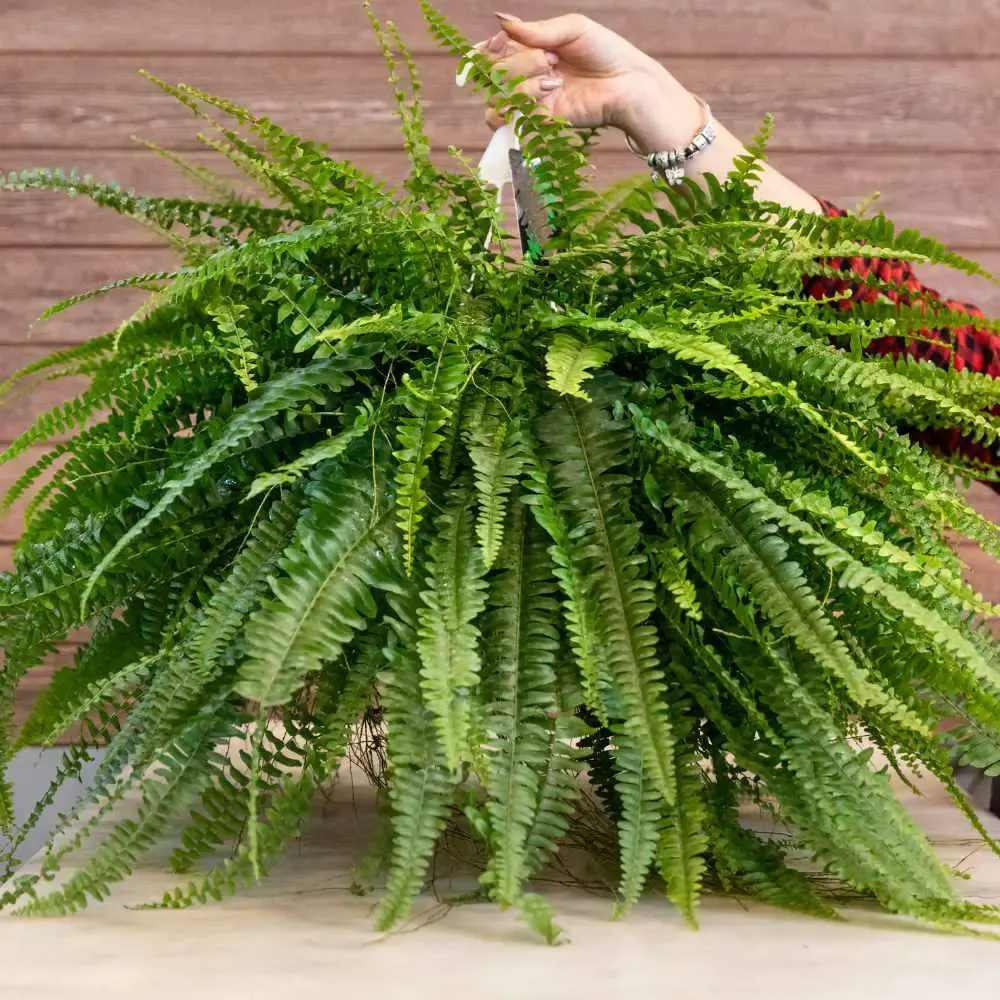
Where should I hang my Boston fern?
Boston ferns are often a great choice for adding greenery to vertical spaces. These ferns grow well in baskets and prefer bright, indirect light and high humidity. so place the Boston fern in a location that provides these growing conditions. They can be hung near a window or placed in a humid bathroom or kitchen to help maintain the right humidity levels.
Outdoors, place them in dappled light or under a patio structure that offers bright indirect light. If your outdoor area has dry air frequent misting is a must.
How long do Boston ferns live? With proper care, a Boston fern can live for several years, up to decades with proper care and the best growing conditions.
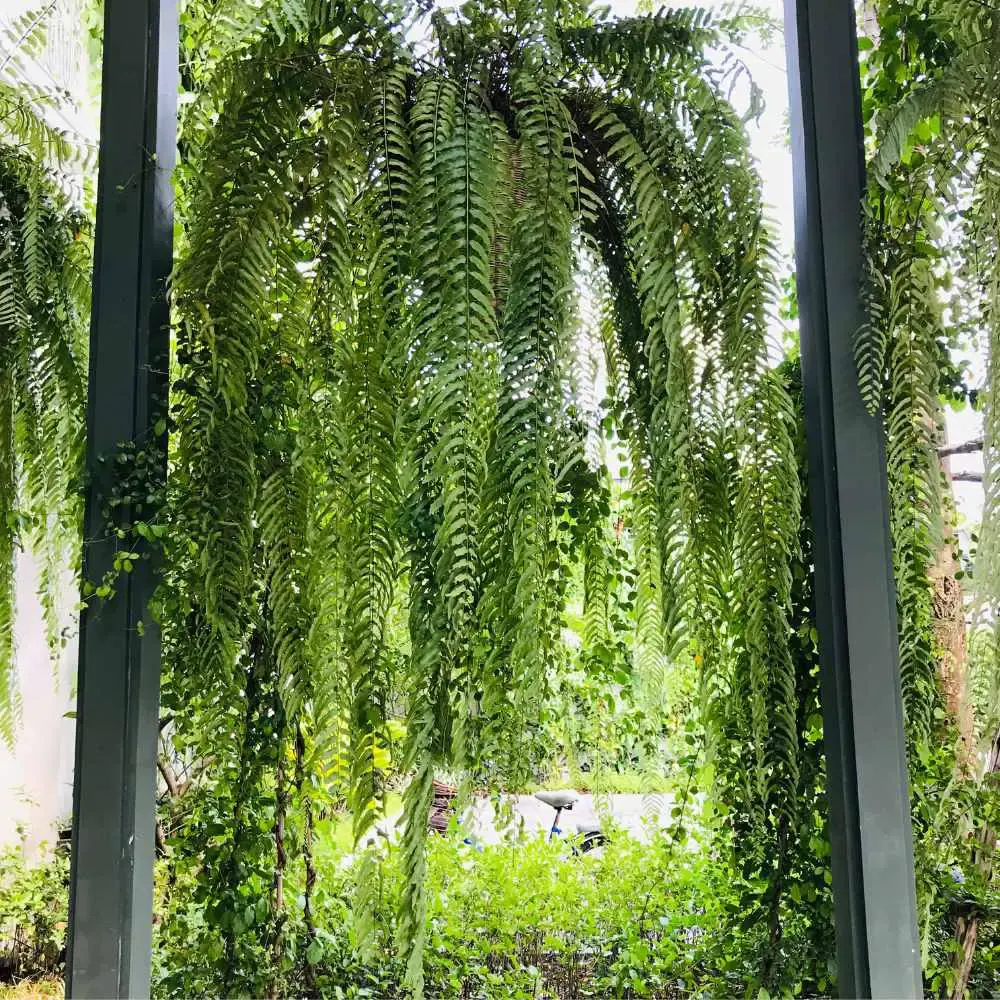
Growing Boston Fern Outdoors:
Boston ferns do well grown outdoors in warm, humid climates. Growing zones 9 to 11 preferred. If your outdoor temps fall below 60 degrees F bring the plant in until temperatures warm.
Follow these tips for growing Boston ferns outdoors:
- Choose a location: Boston ferns prefer partial shade and well-draining soil. They also require high humidity, so choose a location that provides these growing conditions.
- Planting: Plant Boston ferns in the spring or fall, and make sure to space them at least 2-3 feet apart. The soil should be rich and well-draining.
- Watering: Keep the soil consistently moist, but not waterlogged. Water the ferns deeply once a week, and increase watering during periods of hot, dry weather.
- Fertilizer: Fertilize the ferns every 4-6 weeks during the growing season with a balanced fertilizer.
- Pruning: Prune any dead or yellow fronds as needed to keep the plant looking healthy.
Sourcing a Boston Fern:
This plant is very easy to find at your local garden shop. Most often is they don’t have a Boston fern it is no trouble to order one in for you. If your area doesn’t carry them you can always order on online through Etsy or other garden sites.
Just be sure your using a reputable online source with LOTS of good reviews. We mostly use Etsy since we can support small family businesses that are often experts in growing and shipping the plants they sell.
Boston Fern Care Tips:
Are Boston ferns hard to care for? Boston ferns are not necessarily hard to care for, but they do require specific growing conditions to thrive. Here’s a general guide for what conditions a Boston fern requires for best growth and well being.
Care tips for Boston ferns:
| Care tip | Description |
|---|---|
| Light | Bright, indirect light |
| Watering | Consistently moist soil |
| Humidity | High humidity( 45 to 60 %-use humidifiers, pebble trays, plant grouping or misting as needed) |
| Temperature | 60-75°F (16-24°C) |
| Fertilizer | Monthly during growing season with balanced fertilizer. TIP: In addition -2 tsp of epsom salt in a gallon of water makes luscious ferns when applied monthly. |
| Soil | Well-draining, rich soil |
| Pruning | Prune dead or yellow fronds as needed |
Growing Habit of Boston Ferns:
The growing habit of a Boston fern is characterized by its large, arching fronds that emerge from a central crown. The fronds grow up and then fall over to cascade over the sides of baskets, walls, pedestals or shelves, as you like. The fern fronds can grow from three to seven feet in length, depending on conditions.
Boston ferns are known for their vigorous growth habit, and they can quickly fill out a container or hanging basket. As the plant grows, it will produce new fronds from the center of the crown and will eventually develop a dense, bushy appearance.

Pruning This Fern:
Pruning a Boston fern is a simple and straightforward process that helps to keep the plant healthy and looking its best. Just be sure to use sharp, clean tools, and make clean cuts to avoid damaging the remaining plant tissue.
Tips for pruning your Boston fern:
- Identify the fronds that need pruning: Take a close look at your Boston fern and identify any fronds that are turning yellow or brown, are damaged, or are simply getting too long.
- Prepare your tools: You’ll need a sharp pair of pruning shears or scissors to make clean cuts. Be sure to sterilize your tools with rubbing alcohol or bleach to prevent the spread of disease.
- Cut back the fronds: Using your pruning shears or scissors, cut the fronds back to the base of the plant. Be sure to make a clean, angled cut to prevent damage to the remaining plant tissue.
- Remove any dead or damaged material: Take a closer look at the plant and remove any dead or damaged material that you may have missed during the initial pruning.
- Dispose of the clippings properly: Gather up the clippings and dispose of them in the trash or compost. Do not leave them in the soil or on the plant, as they can attract pests and disease.
- Water and fertilize: After pruning, be sure to give your Boston fern a thorough watering and a dose of fertilizer to help it recover and continue growing.
Propagation Methods:
Boston ferns are easy to propagate through several methods, including division, spores, and stem cuttings.
- Division: The most common way to propagate Boston ferns(and the easiest) is by dividing the plant when it outgrows its pot. To do this, carefully remove the fern from its pot and gently separate the root ball into two or more sections. Each section should have its own roots and several healthy fronds. Replant each section in its own pot with fresh potting soil and water thoroughly.
- Spores: Boston ferns can also be propagated by spores. But this will take a LOOONG time (think year or more) so it is not often practical expect for home science projects. :). To propagate this plant by spores: wait until the fern produces spores, which are small brown or black dots that appear on the underside of the fronds. Collect the spores and sprinkle them on top of moist potting soil. Cover the pot with plastic wrap or a plastic bag to create a humid environment, and keep the soil moist. The spores will eventually germinate and develop into tiny new ferns.
- Vegetative propagation (stem cuttings): Boston ferns can also be propagated through vegetative propagation. This is easy to do and involves taking cuttings from the plant and rooting them in water or potting soil. Just take a stem cutting that is several inches long and has healthy fronds attached. Remove the lower leaves from the stem, leaving only a few at the top. Place the cutting in a container of water or potting soil, and keep it moist until roots begin to form. Once the cutting has developed roots, it can be planted in its own pot.
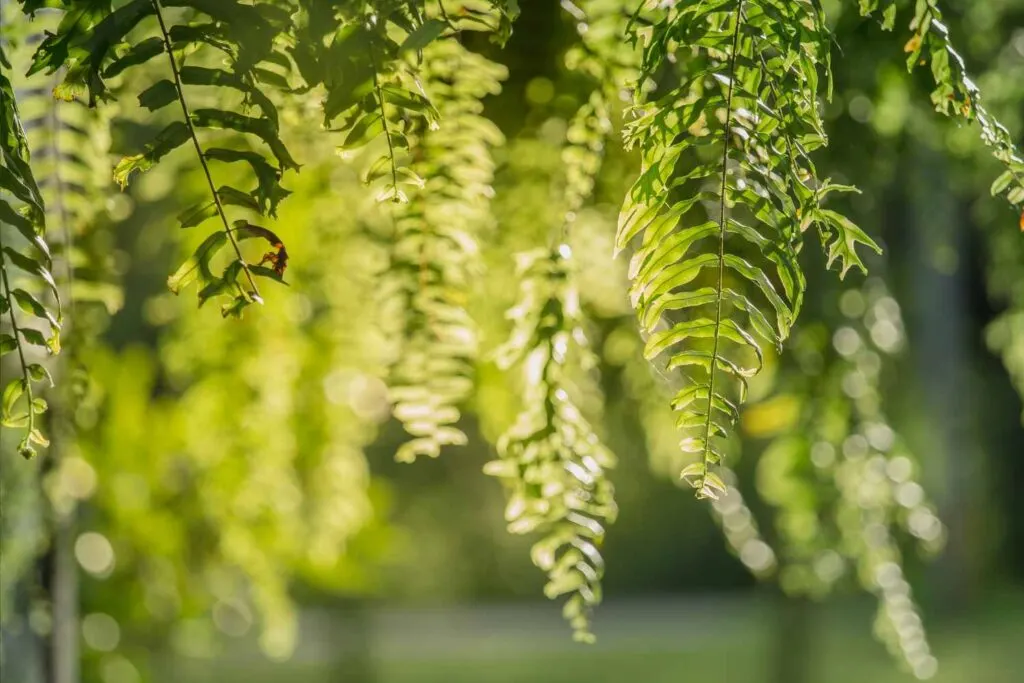
Trouble shooting: Signs a Boston fern is unhappy or unhealthy:
To keep your Boston fern healthy and happy, you must provide it with the right growing conditions. Boston ferns require bright, indirect light, consistently moist soil, and high humidity to thrive. If you notice any of these signs, adjust your care routine accordingly, and your plant should start to recover.
Here are some things to look out for:
- Brown or yellow fronds: If the fronds of your Boston fern are turning brown or yellow, it may be a sign that the plant is not getting enough water or humidity. It could also be a sign of overwatering, hydrophobic soil, pests or a nutrient deficiency. Read this post on watering plants properly for more.
- Drooping fronds: If the fronds of your Boston fern are drooping or wilting, it may be a sign that the plant is not getting enough water or that the soil is too dry. It could also be a sign of over-fertilization or overexposure to direct sunlight.
- Dry or crispy fronds: If the fronds of your Boston fern feel dry or crispy to the touch, it may be a sign that the plant is not getting enough humidity. This is a common problem for Boston ferns, especially in dry indoor environments.
- Stunted growth: If your Boston fern is not growing as quickly as it should or seems to have stopped growing altogether, it may be a sign that the plant is not getting enough light or nutrients. Read this post on proper fertilizing for more on that.
- Look for pests: Boston ferns can be susceptible to the common pests that can damage or weaken the plants if left untreated. Read this post on the 7 most common pests that affect houseplants and how to treat the plant.
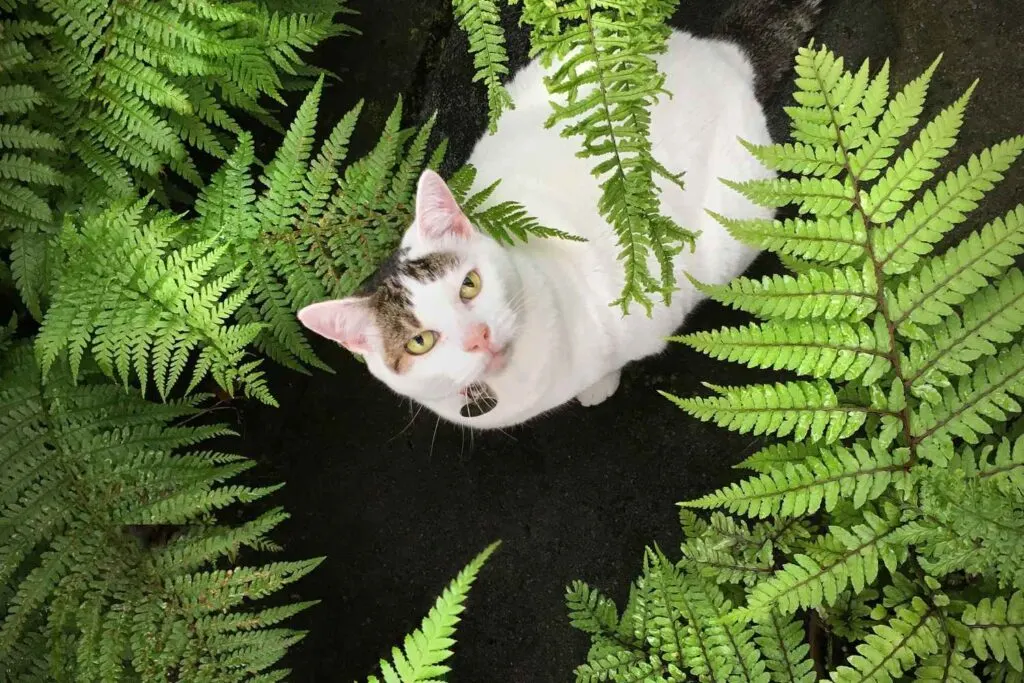
Boston Ferns are Non Toxic to Cats and People:
Boston ferns are a safe, non-toxic houseplant that can add beauty and health benefits to your home. They are safe to have in your home, and even if your pet or child ingests a small amount of the plant, it is unlikely to cause harm. This makes the Boston fern an especially great choice for all indoor spaces, since it also filters air. Very healthy plant companion!
That said, It is a good idea to place the fern in a location that is out of reach of curious pets and children.
While Boston ferns are considered safe, some people or pets may have allergies or sensitivities to the plant. If you notice any adverse reactions such as skin irritation or respiratory issues, remove the fern from your home and seek medical attention if necessary.
Related Content:
Follow Us:
Find us on YouTube, Instagram , Pinterest and TikTok! We love to Plant chat. We also comment, like and occasionally share your content to our daily stories. We’d love to see your plants. Share your joy in your houseplants. Happy Planting!
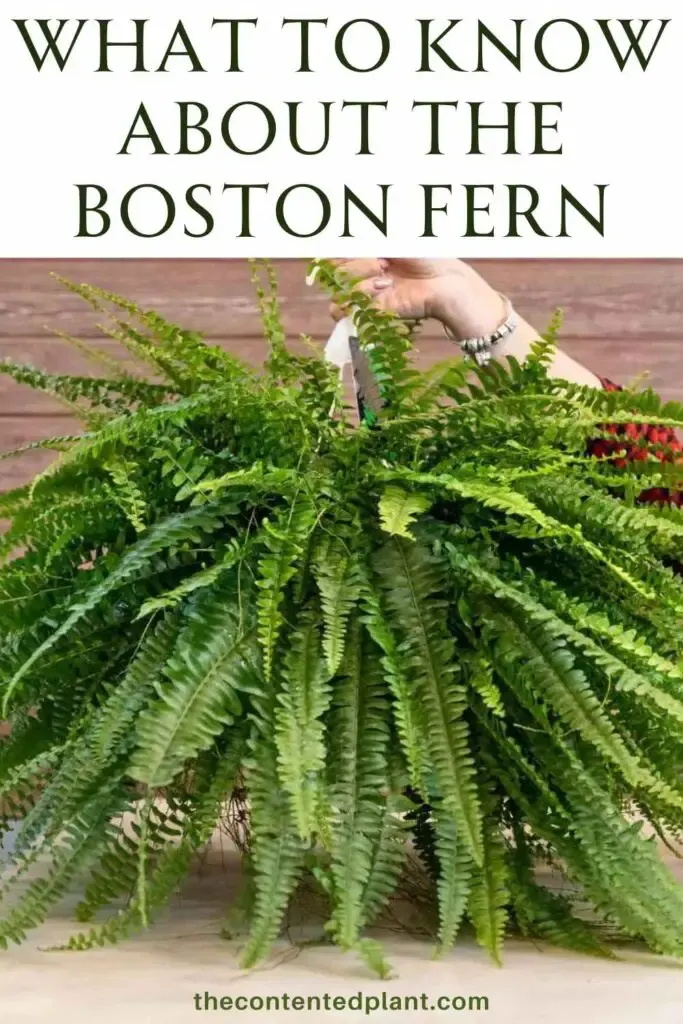

Birds Nest Fern - The Contented Plant
Tuesday 22nd of August 2023
[…] Boston Fern Plant Profile and Care guide […]